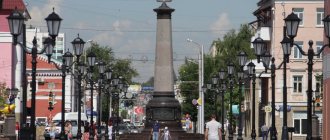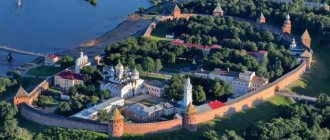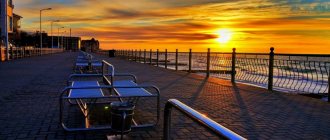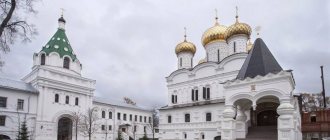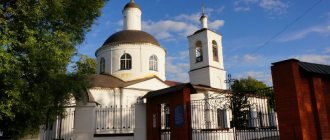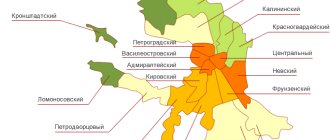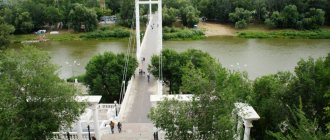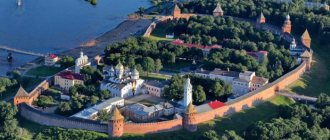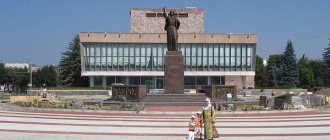The name of the city was given by the Luga River, and its name comes from the word laugas, which translates from Estonian as swamp. A Slavic settlement existed here already in the 10th century. During the reign of Catherine the Second, by her order, a city was built on Luga.
The poet Nadson, who visited Luga at the very beginning of the 19th century, gave a detailed description of the city. Alexander Sergeevich Pushkin stopped here several times on his way to his Pskov estate. He did not describe this town very flatteringly:
There is a city in Russia called Luga, in the St. Petersburg district. This little town wouldn’t be any worse if it weren’t for my Novorzhev in the world.
During the Great Patriotic War there were heavy battles here. The city was severely destroyed, but many houses miraculously survived.
City Museum
Address: st. Red Artillery, 11-a Phone: (81372) 2-36-41 Website: museum.ru/m253 Opening hours: 11.00-17.00, closed: Sunday, Monday Cost: 60 rubles
The museum was created in 1976. It is located in a former merchant mansion of the first half of the 20th century, which survived the battles and occupation. The exhibition presents several main collections:
- collection of materials from archaeological excavations of burial mounds of Slavic tribes
- collection of coins
- ethnographic collection
- collection of old photographs
- documents associated with the names of N. Nekrasov, A. Kuprin, M. Saltykov-Shchedrin, B. Kustodiev, I. Kramskoy, astronomer S. Glazenap
The stands contain materials about the stay here of Rimsky-Korsakov, Mussorgsky, Chaliapin, and the storyteller Ershov. A large place in the museum's exhibition is occupied by materials dedicated to the war of 1941-1945: military operations, the partisan movement, and the exploits of a detachment of Spanish anti-fascists.
Entertainment and active recreation
On the banks of the Luga River of the same name there is a professional motorcycle track. There you can ride motorcycles, SUVs and ATVs. In winter, the track is dominated by snowboarding and ski jumping. Tourist bases rent equipment and additionally organize fishing and hunting.
The Kalganovka estate houses an equestrian center. You can ride horses in the ancient park and take care of them yourself.
Excursions
- Professional excursion in the city itself, through the Local History Museum. The cost of the excursion is from 800 rubles.
- From St. Petersburg “Forgotten estates of the Luga region.” Takes 15 hours. Cost from 1500 thousand per person.
Where to stay
There are many places for travelers to stay in the city:
- Recreation center "Mill on the Black River". Cost from 2750 rubles per day to 7500 rubles per day.
- Mini hotel "At Lysaya Gora" st. Srednyaya Zarechnaya, house 71a. Room cost 2500 rubles/day. Rooms with extra bed – 3000 rubles per day. Breakfast 300 rubles, dinner 500 rubles.
- Mini hotel Vasilisa st. Nizhegorodskaya, 61. Room cost per day is 1500 rubles.
- Hotel "Luga" Kirova Ave., 56. Room cost: 500 rub. night for a regular room. Double room with amenities 2500 rub. day.
Find other hotels and guest houses on the Luga city portal.
Meadows is an excellent, quiet, and at the same time interesting place. Cozy streets, beautiful parks. Here everyone can choose the theme of walks, city promenades and nature trips. The most beautiful time comes in autumn. The city dresses in bright clothes, the surrounding forests flare up in the sun. Immersing you in an atmosphere of serenity and unhurriedness.
AuthorMargarita Tumanova
Interested in last minute tours?
See what options are available for your dates. The site monitors offers from 120 companies. There is a convenient system for searching and filtering offers. All prices are final. Flight and accommodation are already included. Prices start from 6,000 rubles per person.
useful tips for readers of the LHTravel website
Important PS If you have a minute, check out how our move to the US and adaptation to the new place is going.
Read about moving to the USA
What is a souvenir and how to choose one Souvenir products are a real headache for any traveler. I really want it, but it's expensive. How to choose a souvenir? There is an answer. Look
Description of the attractions of Rostov the Great Let's briefly talk about the main attractions of Rostov the Great - the city where the famous film “Ivan Vasilyevich changes his profession” was filmed. Look
Food in Italy and a man-made waterfall Arseny Vesnin talks about where to look for real Italian cuisine and shares his impressions of visiting an artificial waterfall. Look
Review of a trip to Singapore We are publishing a new note by Sofia Glazunova. In it she talks about her impressions of her trip to Singapore. Read before your trip! Look
Last minute tours to Greece Use the LevelTravel search form to find a suitable tour to Greece. Click on the offer you like, so you will see a detailed description of the trip (tips, example). Look
Holidays in Alanya in October Let's talk about whether to fly to Alanya in mid-autumn. How is the weather, is it possible to swim in the sea, what is the water temperature? Look
Cathedral of Our Lady of Kazan
Address: Gagarin st., 27 Telephone: (81372) 2-24-56 Opening hours: 9.00-18.00
The neo-Byzantine style temple was built at the end of the 19th century on the initiative of local residents. Representatives of the merchants and nobility collected funds for its construction. Architect N. Kudryavtsev donated a shrine to the church - a cross with particles of the Life-Giving Tree.
The miraculous icon of the Dormition of the Blessed Virgin Mary is kept here. During the defense of Luga in 1941, the headquarters of the 41st Rifle Corps was located here. In 1942, the church was consecrated, and services began there and continued until the end of the war. The building was empty for a long time, but services have now been resumed.
Recommendations
Sources
- Legislative Assembly of the Leningrad Region. Regional Law No. 32-oz of June 15, 2010 “On the administrative-territorial structure of the Leningrad region and the procedure for changing it,” as amended. Regional Law No. 23-oz dated May 8, 2014 “On the merger of municipalities” Primorskoye urban settlement of the Vyborg district of the Leningrad region and Glebychevskoye rural settlement of the Vyborg district of the Leningrad region and on amendments to certain Regional laws. Came into force on the date of official publication. Published: “Vesti”, No. 112, June 23, 2010 (Legislative Assembly of the Leningrad Region. Regional Law No. 32-oz of June 15, 2010 “ On the administrative-territorial structure of the Leningrad Region and the procedure for changing it” as amended
by Regional Law No. 23-oz dated May 8, 2014
On the annexation of the municipalities “Primorskoye Urban Settlement” in the Vyborg District of the Leningrad Region and the “Glebychevskoye Rural Settlement” in the Vyborg District of the Leningrad Region and on amendments to various regional laws (
comes into force on the date of official publication ). - Legislative Assembly of the Leningrad Region. Regional Law No. 65-oz of September 28, 2004 “On establishing boundaries and conferring the status of a state municipal formation on the Lugansk municipal district and the municipalities within it,” as amended. Regional Law No. 17-oz dated May 6, 2010 “On amendments to some regional laws in connection with the adoption of the federal law “On amendments to certain legislative acts of the Russian Federation in connection with improving the organization of local self-government””. Came into force 10 days from the date of official publication (November 1, 2004). Published: “Bulletin of the Government of the Leningrad Region”, No. 31, October 22, 2004 (Legislative Assembly of the Leningrad Region. Regional Law No. 65-oz of September 28, 2004 “ On establishing boundaries and assigning the appropriate status to the municipal formation of the Luga municipal district and its constituent its composition to municipalities
, with changes made by the region").
Law No. 17-oz of May 6, 2010 “ On amendments to Article 2 of the regional law “On establishing boundaries and assigning the appropriate status to the municipal formation of the Lodeynopolsky municipal district and its constituent municipalities
. after 10 days from the date of official publication (November 1, 2004).
Church of the Holy Great Martyr Catherine
Address: Kirova Ave., 54 Telephone: (81372)2-23-41
Built with money allocated from the treasury by Catherine II, it became the first church in the city of Luga. This is a modest building, reminiscent of a Protestant church in architecture. The temple is decorated with a monumental portico with columns and a modest semicircular apse.
In the 30s, the church was closed, and a children's cinema operated there for some time. Since 1993, worship services began to be held there again.
Natural attractions
Kropovskie caves
Sand was mined here for glass production. Note the interesting oval and round vaults. In some places, the soot of partisan fires remains. Mysteriousness and inhospitability attract tourists here. They are located on the territory of an artillery installation; some of the caves have been closed by the military and are not allowed into the facility. There is a secret path from the Obla River. To protect yourself, you need to contact an experienced digger-tour guide.
Luga Canyon
The area of modern Luga was formed due to the collapse of the glacier. The splendor of nature is mesmerizing, rocky shores, waterfalls, a small canyon. Near the Oredezh River near the abandoned village of Ploskoye. The river flows into a lake around which there are green banks and tall pine trees. The river broke through the rocks and formed an amazing sight - a canyon in the Leningrad region. The most spectacular time is spring - summer, when the water runs, sparkling and bouncing on the rocks.
Landscape reserve "Cheremenetsky"
The Cheremenetsky Landscape Reserve is located 8 kilometers from the city of Luga. It carefully cares for unique species of trees and animals. Particularly important are areas of broad-leaved trees: coniferous-deciduous and elm forests. Red Book animals have found their home in forests and lakes:
- crested newt;
- lake frog;
- White stork;
- garden dormouse;
- green woodpecker, roe deer.
The reserve contains estates with parks and the Ionno-Theological Monastery.
Resurrection Cathedral
Address: Kirova Ave., 54
Nearby, at the same address as the Church of St. Catherine, is the Resurrection Cathedral, erected in 1887 with donations from townspeople. This is a single-dome building in the pseudo-Russian style with a three-tiered bell tower.
In the thirties, a dance floor was opened here; during the war, a German military unit was located. The building is now being restored and services are held here.
Small Luga Canyon
(coordinates 58°49'28.7″N 29°59'08.6″E)
Let's start with the fact that you shouldn't look for the Grand Luga Canyon, although this is quite logical. It simply does not exist in nature. And the Small Canyon is called that only because of its size. Don't expect to be surrounded by towering mountains with a rushing river running through them. The Luga landscape is much more modest, but sweeter to the Russian eye.
You can get here if you are near the village of Zheltsy and take the E-95 highway to the left. Follow the navigator, it won’t let you down. The road will lead through the forests to a rectangular quarry, which was flooded several decades ago during the production of quartz sand.
The quarry itself is very pleasant, with clean, clear water and equally clean, almost white sand. It is already fairly overgrown with trees and only by its outlines can one understand its man-made origin.
But the canyon, on the contrary, was created by nature. More precisely, an amazing small stream that flows out of the forest. It’s simply amazing that this small stream could carve a canyon four meters high in the ground. They say, however, that during the spring thaw the stream becomes quite stormy, but on a quiet autumn day there is no water at the bottom at all and the small waterfall completely dries up at the beginning.
The canyon is quite short, only a couple of turns. It won’t take much time to examine it, but you can take a lot of unusual photographs. The steep banks are very picturesque. Probably no one will say how many millions of years can be found in these quartz layers. Tree roots hang from above, and visitors add some color in the form of modern rock art.
Conclusion: a pleasant, unusual natural place that you can simply find, quickly explore, and then brag about your impressions.
Church of St. Nicholas the Wonderworker
Address: Vrevskoe cemetery
The red brick church was erected at the expense of the Luga merchant Alexandra Tretyakova and was conceived as a temple-tomb for her husband. The tomb was built in the basement of the church. After the revolution, they tried to blow it up, and now the temple is practically in ruins, but the issue of its restoration is being decided.
Where the meadows meet
45 main attractions of Yaroslavl
Meadow ecosystems are located in places where natural conditions are unsuitable for the normal existence of tree forms: in frequently flooded low areas of river valleys (floodplains), steppes, semi-deserts, coasts of the subarctic and subantarctic zones, on mountain slopes. Natural grasslands are common in New Zealand, the temperate zone of the Northern Hemisphere.
Meadows are confused with fields or steppes, but the differences are significant. Agricultural crops are grown in the fields and are regularly processed by humans. In the steppes, due to poor moisture, drought-resistant grasses grow, and their development stops not only in winter, but also in summer.
Church of St. Nicholas
Address: pl. Uritskogo, 44
At the beginning of the 19th century, a Catholic church built in the traditions of Gothic architecture was consecrated in the city. The construction was supervised by the architect Dietrich.
In the 30s, the church ceased to function, then services were held for some time during the German occupation. During Soviet times, the building was used as a gym, but recently the church has been operating again.
In his yard there is a monument to unborn children.
Story
It was founded on the banks of the river of the same name by decree of Catherine the Great on August 3 (14), 1777. The city developed in the following stages:
- Initial construction (1777–1800)
- Early population growth to 3,000 (c. 1810–1860)
- Intensive social and urban development (c. 1870–1910)
- Soviet development according to a typical small town plan (1926–1950).
- Reconstruction of the historical structure of the city (ca. 1960 – ca. 1995).
- Transition to a free market agro-industrial town (c. 1995–2005)
Luga was founded as a city in the Pskov governorate, but on March 3 (14), 1782 it was transferred to the St. Petersburg province (renamed Petrogradsky in 1913 and Leningradsky in 1924) and became the seat of the Luga district. In 1918, important events of the Russian Civil War took place here, when the White Army unsuccessfully tried to capture Petrograd.
On August 1, 1927, the districts were abolished and the Luga district was formed with the administrative center in Luga. The akimats were also abolished, and the district became part of the Luga Okrug in the Leningrad Region. On July 23, 1930, both okrugs were abolished, and the districts were directly subordinated to the region. On September 19, 1939, Luga became a city of regional significance and ceased to be part of the district.
The World War II German offensive on Leningrad was temporarily suspended by seven regular, militia, and irregular units in the Luga area, and this delayed the start of the siege of Leningrad by more than a month. In recognition of this feat, the city was awarded the title of "Hero City" and listed as one of the World War II Cities of Military Glory by Vladimir Putin, the President of Russia. The German occupation of Luga lasted from August 24, 1941 to February 12, 1944.
In 2010, the administrative structure of the Leningrad region was brought into line with its municipal structure, and Luga became a city of district significance.
Memorial of Partisan Glory
Address: Kievskoe highway, 135 km How to get there: located at the entrance to the city. You can get there by car or get off the St. Petersburg train at General Omelchenko's Razezd station.
The memorial was built for the thirtieth anniversary of the victory on a twenty-meter hill and is dedicated to the partisan movement. Monumental structures include a reinforced concrete pillbox left over from the war, 13 stelae-boulders representing the number of partisan brigades, and a monument to the partisans with a memorial hall.
How to get there
You can get there in three ways:
- By car - 150 kilometers, approximate cost of gasoline is 600 rubles.
- By train - they go from the Baltic Station, check the schedule on the Russian Railways website. Cost 430-470 rubles per trip.
- Buses run from the Obvodny Kanal metro station, schedule on the city website. Cost 220-260 rubles.
St. John the Theologian Cheremenets Monastery
Address: Luga district, Skreblovo volost, Cheremenets Telephone: (81372) 5-83-86 How to get there: from the bus station by bus 138-A, 138-B138-B, route Luga-Skreblovo-Cheremenets-Krasny Val-Luga or by shuttle taxi to the Krasny Val stop.
There is no exact information about the founding date of the monastery. According to researchers, the monastery was founded in the 15th century, although based on materials from archaeological expeditions it is clear that the monastery was here much earlier.
According to legend, an icon of John the Theologian appeared to a peasant from the village of Rusynya. Ivan the Third, having heard about the miracle, ordered the construction of a monastery on the island. At the end of the 16th century, it was destroyed by the Lithuanians, but the monastery was quickly restored, and it served as a refuge for the monastic brethren until the 30s of the 20th century.
Then on its territory there was a gardening school and a recreation center. In 1997, monastic life was resumed.
Where is the city
Luga, whose attractions are historical structures and buildings, was founded as a Luga settlement in the 16th century. The settlement received city status on August 3, 1777, during the time of Empress Catherine II Alekseevna the Great. After this, it becomes the administrative center of the Luga region and the regional municipality.
It includes:
- city;
- cordon;
- 2 villages;
- village.
The city is located on the river of the same name, at a distance of 130 versts from the city of St. Petersburg and 735 versts from the Moscow region.
The area covered by the city is 13 km². Geographic coordinates of Luga: 58°44′13″ N. and 29°50′43″ E, the height of its center above sea level is 48 m. According to the 2019 census, 35 thousand people live in the region. In terms of population, among 1,117 cities in Russia, Luga ranks 446th. The largest population growth occurred in the 30s, 40s and 90s of the last century.
Numerous industrial enterprises and factories are located on the territory of the city:
- The only plant in Russia for the production of containers for heating, combustion and melting.
- Plant for the production of sausage casings.
- Mining processing plant.
- Factory for the production of water filters.
- Factory of electrical products.
- For the production of automobile parts.
- Feed production plant.
- Canning production.
- Chemical factory.
- Dairy, meat and bread factories.
The main events that took place in the life of the city and its population:
| Year | Description |
| 1781 | the city of Luga becomes a local county |
| beginning of the 16th century | Alexander Pushkin visits the city |
| period from 1852 to 1857 | in the area of Preobrazhenskaya (Tolmacheva) station an iron bridge is being erected on a stone pedestal |
| 05/17/1914 | The first air flight in history took place on an airship at night, from the city of Gatchina to Luga and back |
| 1927 | Luga becomes the administrative center of the region |
| 1930 | in the region the status of the Luzhsky district was abolished |
| 1939 | the city is being transformed into an administratively independent unit |
| 1941 | the city is the site of fierce battles and does not allow the Nazis to approach Leningrad. |
| 08/24/1941 | for 902 days the city is occupied by the Nazis |
| 02/12/1944 | The Soviet Army liberates the city |
| October 1959 | city government functions transferred to the City Council |
| 02/01/1963 | the board passes to the Council of Deputies of the region |
| January 1, 2006 | the city becomes a municipality exercising local self-government |
| August 2, 1977 | the city was awarded the Order of Merit in the Patriotic War |
| May 5, 2008 | The title of “City of Military Glory” is being awarded |
Luga, whose sights are of great interest, is the southernmost city of the entire Leningrad region. The Obla River flows from the north-west of the city, its mouth is located 2 km along the left bank from the Vrevka River. Nearby there is a lake called Omchino, whose height above sea level is 43 m.
There are various ways to get to this unique city. The city does not have its own airport, but you can fly to the nearest airports. Then get to the city by bus or car.
Air terminals closest to Luga:
- "Pulkovo" in St. Petersburg, is located at a distance of 146.12 km;
- “Crosses” in Pskov is located at a distance of 163.87 km.
Both airports serve intercity and international flights. You can get to the city by rail. The railway station called “Luga-1” is located at: Luga, st. Malaya Inzhenernaya Building 11. The station is open daily, 24 hours a day. Luzhskaya railway station belongs to the St. Petersburg-Vitebsk branch of the Oktyabrskaya Railway.
You can get to Luga by intercity bus. The bus station is located at: Luga, st. Alexey Yakovlev building 13.
Urban architecture
County government
Address: Kirova Ave., 64
The building was constructed at the end of the 19th century.
Architectural complex "Public Places"
Address: Svyazi Lane, 4
The complex was built in the 18th century, and now the fence, central building and outbuilding have been preserved.
City mansion of the early 20th century
Address: st. Tosi Petrova, 11
Train Station
Address: st. Malaya Inzhenernaya
It was built in 1944 under the leadership of architect Baryshkin. Before the war, there was a train station built here in the 19th century. It was destroyed during the battles for the city.
Ostrich farm near Luga
(coordinates: 58°39'41.8″N 29°54'29.3″E)
If you know that the village of Rapti is now called the village of Dzerzhinsky, then you can look into another unusual place. To the ostrich farm. It is only about 500 meters from the manor ruins. Even a short road there will bring tremendous pleasure, because it runs along an ancient linden alley. It is difficult to say how old these trees are and whether they can compete with the famous American redwoods, but they make a great impression.
The Ostrich Kingdom is located right at the end of the alley. Here, not only real African ostriches roam freely, but also ducks, geese, pheasants and guinea fowl. You can feed them, you can dance with them. Tours run every two hours.
Conclusion: a nice outdoor petting zoo for walking with children and creating unusual photos for the family archive.
Rapti Manor
The remains of the famous estate are located near Lake Cheremenetskoe. The manor was built in the Baroque style and was considered the richest and most luxurious place in the area. Often local residents called it the Versailles of Luga, for the boldness of its architectural solutions.
Many famous people, such as I.N. Kramskoy, we were looking for inspiration here. But during the revolution of 1917, a state farm of the same name was formed here, and in 1918 the estate was classified as an architectural monument and taken under protection, and the NKVD sanatorium was located in the main building. Over time, the village of Rapti was renamed the village of Dzerzhinsky. During the Great Patriotic War, the village was occupied, and in 1944, during the retreat, the Germans blew up the main building of the estate. To this day, only the arch, which miraculously survived, and the remains of the main staircase remind of its former luxury.
Hotels
Now that you know what Luga is, you should definitely come here. Here you can not only have a good rest, but also get acquainted with the rich history of this region. The city of Luga has a sufficient number of hotels and inns that provide all the necessary conditions for living. We invite you to familiarize yourself with the most popular of them:
- Recreation center "Shtol" - Partizanskaya street, 30. It offers comfortable rooms that have everything you need for relaxation. The hotel is located on the banks of a river where you can not only swim, but also fish.
- Guest house "Sakhalin" - Luzhsky lane. If you are tired of city noise, then you will certainly like this option. There is free internet, a shared kitchen with everything you need for cooking, and convenient parking.
- Country house "Sosny" - Tolmachovo village, Smolyanaya street, 26. You will enjoy clean air in one of the most popular hotels in Luga. The cottage is located in a forest area. Comfortable gazebos have been built on the territory, which have everything you need for a barbecue.
- Guest house on Komsomolsky. In the city center you can rent quite comfortable rooms to stay at affordable prices. The hotel is located on Komsomolsky Avenue, 16 A.
Where to relax in Luga
Today, the Luga district is the largest province of St. Petersburg in terms of the number of gardens. Thousands of St. Petersburg residents move to Luga and the surrounding area for the summer to enjoy the silence and the purest balm of pine forests.
Here are the famous massifs “Mshinskaya”, “Nizovskaya”, “Divenskaya”. There are many smaller ones scattered along the shores of lakes, in river openings and forest edges of gardening and dacha villages.
On the territory of the district there are the largest complex federal reserve in the region “Mshinskoye Bog” (60 thousand hectares), complex reserves - Syabersky, Shalovo-Perechitsky and Cheremenetsky.
Natural monuments - relict forests of the Linden Mountains tract, caves of artificial origin - Korpovskie near Luga and Oredezhskie on the shore of Lake Antonovskoye, boulder fields near the village of Maloye Konezerye, sand dunes near the southern outskirts of the city of Luga, the area of the village of Zhelezo with botanically valuable coniferous species and deciduous trees.
Among the groundwaters there are mineral waters (Cambrian sodium chloride waters). A mud bath using sapropel mud from Lake Nelai is included in the balneological complex of the Zeleny Bor health resort.
Characteristic fauna
Large animals do not live in open areas, so the species diversity of the meadow biocenosis is represented by small lizards, rodents, and inconspicuous birds. The upper layers of soil are inhabited by larvae and worms, which are eaten by moles, hedgehogs, and snakes. Amphibians are also found, which characterizes the biocenosis of the water-rich meadow.
Insects are especially diverse; they are content with a wide selection of vegetation and nectar. There are numerous beetles on the surface of the earth, and flies, cicadas, and locusts in the grass.
| Animal class | Meadow representatives |
| Insects | Hairy bee, meadow moth, swallowtail, cabbage grasshopper, flea beetle, dung beetle, ants |
| Amphibians | Grass frog, green toad, spadefoot |
| Reptiles | Agile lizard, common |
| Birds | Whisker, Dubrovnik bunting, yellow wagtail, corncrake, lapwing, gray warbler, lentil, shrike, warbler, corncrake, quail, snipe |
| Mammals | Common vole, mole, hedgehog, gopher |
Estate "Borovoye"
The estate is located in a pine forest on the shore of Lake Cheremenetskoe. Architect Semyon Petrovich Ivanov created a gorgeous composition in the neoclassical style. The owner of the estate complex was the entrepreneur G. A. Lvov, who needed a country residence for receptions. But the entrepreneur was not destined to use the estate for long. Immediately after the revolution, a home for homeless children was located here. In 1940, the estate was reclassified as a sanatorium for the NKVD. At the moment, a sanatorium of the Ministry of Internal Affairs is located there.
Address: n/a Cheremenets.
Borshchovskie (Oredezhskie) caves
(coordinates: 58°50'39.6″N 30°21'17.0″E)
On the way back from Luga to St. Petersburg, don’t be too lazy to turn towards Oredezh along highway 41A-004 to look into the caves. Someone calls them the Oredezh caves, since they are located on the Oredezh river. Someone says that these are the Borshchovo caves, because they are located near the village of Borshchovo and not on a river at all, but on Lake Antonovskoye.
The river in this place actually widens and seems like a lake. You can leave your car on the edge of the village of Borshchovo. Then there is a steep, broken descent that can only be overcome by off-road vehicles. Although it is very pleasant to walk through a small meadow.
And then there is a sign with explanations, the first slide of quartz sand and a path towards the lake and caves.
To get to the caves you need to go a little deeper into the forest along the path along the lake. Here there are trees of incredible antiquity with roots as tall as human beings and huge, no less mossy stones.
The Borshchov or Oredezh caves are cut on the left hand, right in the high coastal banks. They are of ancient, but man-made origin. These are adits. Here in the 19th century, the same quartz sand was mined for glass production.
The total length of the cave system is said to be about 15 kilometers. You can get into the caves on your own; there are no bars anywhere, but doing this without a guide is still not recommended. There are labyrinths inside and possible dangerous collapses, especially after heavy rains. So draw your own conclusions. To be convinced of the fragility of structures, it is enough to touch the wall with your hand. It instantly flows into your palm like a stream of sand.
Although it is quite possible to go into the first halls of the cave system to take breathtaking underground photographs. It’s safe, you just have to bend down at the entrance, and in some places you won’t even spare your knees.
It’s pitch black inside, and phone flashlights don’t diffuse it very well, so it’s better to have something more powerful. The vaults overhead resemble Gothic arches, and the darkness in the passages fascinates, attracts and frightens at the same time. For this reason, chirping swallows settle above the entrances, whose nests look like a small cave town.

